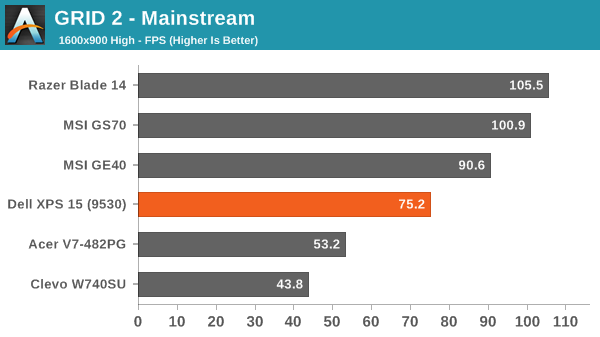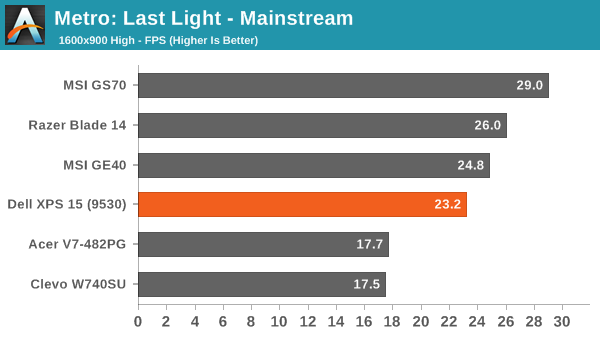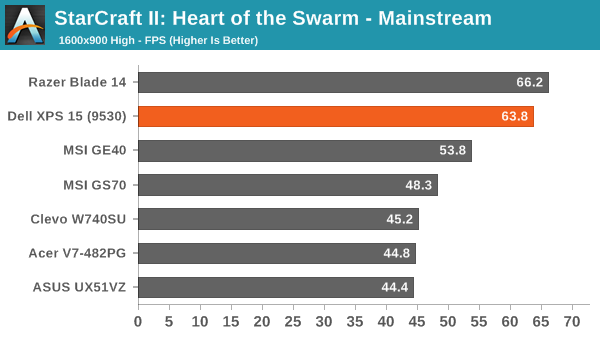Dell XPS 15 Haswell Edition: QHD+ with a Refined Design
by Jarred Walton on March 6, 2014 7:00 AM ESTDell XPS 15: Gaming Performance
With that lengthy preface about throttling, let’s just make it clear that all of the benchmark results here are from post-reboot testing, so throttling should not be present. What we find is that the GT 750M is a reasonable mainstream mobile GPU that can easily handle our “Value” settings and outside of the most demanding titles (e.g. Metro: Last Light) it can run our “Mainstream” settings as well. Not surprisingly, “Enthusiast” quality is mostly out of the question, except with older and/or less demanding titles. As for gaming at the native 3200x1800 resolution, that’s generally more than you can hope to get out of the GT 750M. Some games will certainly break 30 FPS at low to moderate settings, but in most cases opting for a lower resolution with higher quality settings will provide the better experience.
I also want to make note here that with 2014, we’re going to be reducing the number of games we test in our laptop reviews. There’s a real concern that running too many GPU-centric tests can distract from the overall target market for a device. While I’ve gone ahead and included most of the games from our 2013 test suite in Mobile Bench, moving forward we have decided to focus on just four games. Our current list consists of Bioshock Infinite, GRID 2, Metro: Last Light, and StarCraft II: Heart of the Swarm. These should provide a sufficient amount of data that we’ll be able to say how well a system handles gaming workloads. In some reviews we will also include other titles (e.g. if there’s a new GPU that warrants additional investigative work), including some less demanding games that will better illustrate the “casual gaming” aspect.




Considering this isn’t really being targeted at a gaming audience – Dell has their Alienware brand if that’s what you’re after – the XPS 15 still manages to hold its own in the gaming tests. Throttling concerns aside, when the fans and GPU are running as expected, gaming at one fourth the native resolution and high detail settings is easily accomplished, and even 1080p medium/high detail is possible.










152 Comments
View All Comments
darwinosx - Thursday, March 6, 2014 - link
You could not play me to buy Dell anything. Cheap junk and forget about support after you buy.kgh00007 - Thursday, March 6, 2014 - link
How about the WiFi performance?The previous version had poor connection and throughput issues due to a design fault? Is this one any better?
My XPS 15 L502x, which is two generations behind this one, has the exact same throttling issues. I would not buyba laptop with any sign of throttling issues from the start, it will only get worse over time. Look for a laptop with good thermals from the start.
In order to game on my L502x with an i7-2360QM and GT525M, I have to set a "Game" profile with the CPU Max set to 99% to avoid turbo boost on the CPU so that it doesn't cook itself and the GPU. The heatsinks are connected just like they are in this newer model!
jphughan - Thursday, March 6, 2014 - link
WiFi had some issues early on in this system but they turned out to be driver-related. Intel released version 16.6 that seems to have fixed the vast majority of problems. Some people on NotebookReview are still having issues, but they haven't clarified what router or firmware they're running, so I consider those issues within the regular realm of WiFi performance/compatibility issues overall and not something specific to this particular system.dorekk - Monday, June 23, 2014 - link
That's weird, I've never noticed any throttling with my L502X.Dug - Thursday, March 6, 2014 - link
I've read that people have been very happy with the business equivalent which is the Dell Precision M3800. No throttling and seems to run cooler. I'm assuming because it uses the Nvidia Quadro K1100M, w/ 2GB GDDR5. I personally would get the 1080p panel. The scaling with high resolution displays is fine, until you plug in external monitors. Yes you can have different scaling between the laptop and external monitors but it's never plug and play. As soon as you disconnect them, you have to log off and back in to get the correct scaling on the laptop.jphughan - Thursday, March 6, 2014 - link
Or just take the acquisition of this laptop with a QHD+ panel as an excuse to buy a 4K panel! :D Of course that won't help if your apps don't handle scaling well at all as opposed to just having issues with regular DPI and HiDPI coexisting.I have the QHD+ version with a 24" 1200p external display and work around it by either not running the built-in panel at all when at my desk or running it at 1600x900. Yes switching to 3200x1800 and adjusting scaling requires a logoff and logon, which is somewhat irritating, but that's mostly because Microsoft only just delivered an API in Windows 8.1 that notifies applications when there's been a DPI scaling change, and thus those app developers haven't updated their apps to watch for and respond to that API notification. Remember back in Windows 95 when you had to restart your machine even when you changed your desktop resolution? That was true for the same reason, and it's been fixed because applications now watch for and respond to the resolution change notification. The same will happen with DPI scaling.
typicalGeek - Thursday, March 6, 2014 - link
After all the problems my kid has had with his XPS 15 (i5 - don't know exact model) in the 2.5 years he's had it, I would be pretty hard pressed to even consider one.The expensive "Crystal Clear HD" (or some such marketing BS) screen is useless unless viewed "head on" - only a few degrees off in either axis are unviewable, he's had problems with Dell's drivers (for the touchpad & DVD drive), and the 90W battery died without any warning. Still shows 100% charge on the status LEDs. Ha! Dell wanted $150 for a replacement battery, he ended up ordering one off Amazon for less than a third of that - and it included a 18 month warranty. Now his XPS keeps bugging him every start/boot that his battery is not genuine and that he should replace it. Does Dell <i><b>really</b></i> think they're going to convince someone to spend three times as much to get their battery by nagging them every day? All it really does is slow the boot process and tick off the customer. (Who probably isn't too keen that their battery didn't last much past the warranty in the first place.)
JBVertexx - Thursday, March 6, 2014 - link
My biggest beef with Dell now is their website and move to pre-configured models. It used to be so easy to go on the website and pick exactly what I wanted. I've tried numerous times in the last 4 months to go find something I would like, and it's just not there.There are too many models with too few options. The navigation is confusing, and there is no straightforward way to see ALL the models for a particular line you want.
I have a 4 year old Dell Latitude E6410, which was maxed out with the specs when I bought it. I've been happy with Dell laptops as my primary work and do-everything PC since I started buying them 16 years ago.
So instead of buying a new laptop, I just replaced my HDD with a 240GB SSD, then I bought one of the ODD bay adapters off ebay to fit a 750GB storage drive, and I'm all set for now. I'm starting to get in the hurt-locker with my NVS1100 graphics, and I'm starting to find cases where I could use more than 8GB RAM, but I guess I'll just have to suck it up for a while longer.
Really disappointed in what the website and their product lineup have become.
JBVertexx - Thursday, March 6, 2014 - link
Correction - that's NVS 3100M - still in the hurt-locker though.jphughan - Thursday, March 6, 2014 - link
Unfortunately pre-configured SKUs is the new deal. I think it's because in this smartphone/tablet era people overall are less concerned with menial options and more concerned with the overall product. That's not true of everyone of course, but fixed SKUs while continuing to only build to order means savings from a lean inventory and additional savings from fewer manufacturing variances and thus fewer chances of errors and rework.Still, Dell does appear to be passing the savings down to the consumer (likely because consumers are demanding lower prices for what is being seen more and more as a commodity/luxury than a necessity in the smartphone/tablet era). I remember my maxed out Precision M6300 back in the day cost $5200 before discounts. The modern-day equivalent of that system is the Precision M90, and even maxed out it costs less than half that -- despite inflation over the last 7 years. And it's certainly not because the Precision line has gone down the tubes.